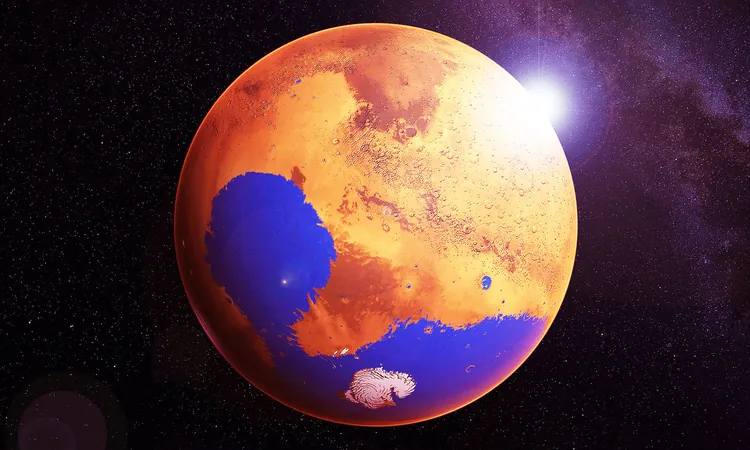
Groundbreaking Discovery: Mars Reservoir Could Cover Planet in Water!
2025-03-29
Author: Mei
Mars, often seen as the barren neighbor to Earth, continues to unveil its secrets. Among its many geological enigmas, the Medusae Fossae Formation (MFF) has caught the attention of scientists worldwide. Located near the Martian equator, this massive expanse, where the smooth northern plains transition into the rugged southern highlands, is suspected to hold drastic implications for our understanding of the Red Planet's history and its potential for human exploration.
Utilizing advanced radar technology, specifically the Mars Advanced Radar for Subsurface and Ionospheric Sounding (MARSIS), researchers have yielded exciting new findings about the MFF. This tool sends signals beneath the surface of Mars and captures the echoes, revealing layers that hint at the presence of a considerable underground water reservoir.
Ice as Thick as 2.2 Miles? Yes, Please!
According to Thomas Watters, a leading scientist at the Smithsonian Institution, recent data shows that the ice deposits beneath the Medusae Fossae Formation may be as thick as 2.2 miles (3.7 kilometers). The radar data indicates that these structures match the signatures of layered ice, similar to what we observe in Mars' polar regions known for being ice-rich.
Imagine this—should these ice deposits melt, they could envelop the entire planet in a layer of water measuring between 5 to 9 feet deep (1.5 to 2.7 meters). This revelation speaks to the magnitude of resources that could exist on Mars, radically altering our approach to planetary exploration and the feasibility of future human settlements.
A Geological Wonder
The MFF is not just valuable for its potential water reserves; it also boasts dramatic geological features. Covering hundreds of miles and towering over a mile high in places, it is composed of dust, ash, and likely substantial ice layers, protected from Mars' harsh environment. Experts believe this vast layer of dust may be responsible for shaping the Martian atmosphere over eons, making it a significant geological marker in the planet’s history.
Revisiting the Past: What Lies Beneath?
Historically, the icy nature of the MFF was suspected but debated, with some scientists proposing it could merely be a giant heap of windblown dust or volcanic ash. However, Andrea Cicchetti from the National Institute for Astrophysics in Italy argues that, given the depth of the MFF, a simple dust pile would lead to greater compaction than what radar has revealed. This suggests that ice is indeed a key component beneath the surface.
Unraveling the Climate Mystery
With its fresh findings, the MFF challenges previously held notions of Martian climate history. Evidence of ancient river channels, ocean beds, and water-eroded valleys illustrates that Mars was not always a dry world; it once supported significant amounts of water. The presence of ice near the equator indicates a time when the climate allowed for such deposits at various latitudes, reshaping our understanding of Martian geology and environmental conditions.
Colin Wilson, the European Space Agency's project scientist, emphasizes the importance of ice reserves for future missions. Identifying water sources in equatorial regions is crucial for human exploration. However, the challenges of accessing these reservoirs, buried under dust layers, still persist.
The Road Ahead in Martian Exploration
Mars exploration continues to reveal astonishing new insights. With tools like MARSIS and the ExoMars Trace Gas Orbiter (TGO), which recently detected hydrogen-rich areas in Valles Marineris—about the size of the Netherlands—scientists believe each discovery brings us closer to understanding Mars’ potential for supporting life and human habitation.
In summary, the findings from the Medusae Fossae Formation are monumental, suggesting that the ice deposits point to a time when Mars was much more hospitable to water. This could pave the way for future exploration missions, making Mars not just a dry desert but a rich expanse filled with untapped resources.
As we continue to unveil the mysteries of our planetary neighbor, one thing is sure: Mars remains full of surprises!


 Brasil (PT)
Brasil (PT)
 Canada (EN)
Canada (EN)
 Chile (ES)
Chile (ES)
 Česko (CS)
Česko (CS)
 대한민국 (KO)
대한민국 (KO)
 España (ES)
España (ES)
 France (FR)
France (FR)
 Hong Kong (EN)
Hong Kong (EN)
 Italia (IT)
Italia (IT)
 日本 (JA)
日本 (JA)
 Magyarország (HU)
Magyarország (HU)
 Norge (NO)
Norge (NO)
 Polska (PL)
Polska (PL)
 Schweiz (DE)
Schweiz (DE)
 Singapore (EN)
Singapore (EN)
 Sverige (SV)
Sverige (SV)
 Suomi (FI)
Suomi (FI)
 Türkiye (TR)
Türkiye (TR)
 الإمارات العربية المتحدة (AR)
الإمارات العربية المتحدة (AR)